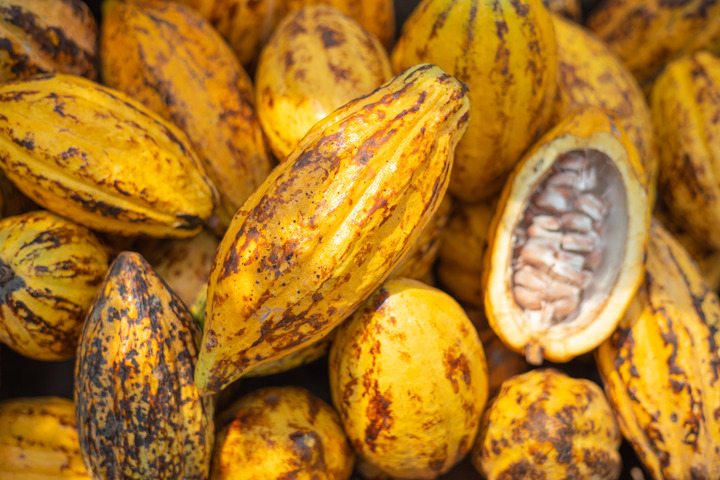Cacao benefits for mind and body have been recognized for centuries, long before it became the chocolate we know today.
This Mexican superfood was treasured by ancient civilizations for its powerful impact on both nutrition and mental health.
Packed with antioxidants, magnesium, and mood-boosting compounds, it helps with stress relief, enhances focus, and supports overall well-being.
Keep reading for cacao benefits for mind and body – and why the Aztecs and Maya called it “the food of the gods.”
Cacao’s Mood-Boosting Benefits
For many, chocolate is the ultimate feel-good treat.
But it’s so much more than a sweet indulgence.
Cacao is a happiness enhancer backed by science.
Cacao contains natural compounds that help uplift mood, making it a fantastic choice for emotional well-being.
Two key components that contribute to this effect are:
- Anandamide: Often called the “bliss molecule,” this compound interacts with the brain’s endocannabinoid system to promote feelings of happiness and stress relief.
- Phenylethylamine (PEA): Sometimes known as the “love chemical,” PEA supports mood and motivation by encouraging the release of dopamine and other feel-good neurotransmitters.
Beyond just a short-term mood boost, cacao can help regulate neurotransmitters like dopamine, serotonin, and endorphins – making it a natural tool for reducing stress and anxiety.
For those adjusting to life in Mexico – from deciphering local bureaucracy to paying the CFE bill – a daily dose of cacao might just be the secret to staying zen.
Cacao is also a great source of magnesium, which supports brain function, muscle relaxation, and stress relief.
A cup of ceremonial cacao or hot chocolate before bed can help promote relaxation and better sleep.
The Physical Benefits of Cacao
Powerful Antioxidants for Long-Term Health
Rich in antioxidants, cacao reduces inflammation and protects against stress, which supports overall well-being.
These compounds support neuroprotection, keeping the brain sharp.
Flavonoids in cacao improve blood flow to the brain, enhancing focus and cognitive function as we age.
Heart Health, Cholesterol Balance, & Lower Blood Pressure
Flavonoids, iron, and zinc in cacao support cardiovascular health by improving circulation and lowering blood pressure.
Theobromine, a natural compound found in cacao, plays a key role in heart health benefits, helping to:
- Lower bad (LDL) cholesterol while increasing good (HDL) cholesterol
- Support healthy blood pressure levels
- Enhance circulation and oxygen delivery throughout the body
This is why theobromine benefits for heart health are often compared to caffeine’s effects, but with a smoother, more-sustained energy boost.
Anti-Aging Benefits
Did you know cacao can be a beauty booster?
Packed with skin-loving antioxidants, especially flavonoids like epicatechins and catechins, cacao helps fight oxidative stress, one of the biggest culprits behind wrinkles, fine lines, and age spots.
It neutralizes free radicals, which protects skin cells from damage and supports a radiant complexion.
But the benefits don’t stop there.
It also boosts circulation, delivering oxygen and essential nutrients to the skin, which improves elasticity and hydration.
Add in its natural ability to reduce inflammation and stress, and you’ve got a superfood that works from the inside out – keeping both your skin and your energy levels glowing.
If you’re interested in more traditional Mexican anti-aging remedies, grab a bar of cacao-rich chocolate and check out this article on Mexico’s Liquid Gold for Ageless Skin.
The History and Cultural Significance of Cacao in Mexico
Cacao has been revered in Mexico for thousands of years.
The Olmecs, one of Mesoamerica’s earliest civilizations, were likely the first to cultivate it as early as 1500 BCE, using it in sacred rituals and possibly as a fermented cacao drink.
But it was the Mayan and Aztec cacao rituals that cemented its sacred status, a symbol of power, divinity, and connection to the gods.
Both civilizations recognized cacao benefits for mind and body, using it for spiritual ceremonies and offerings to the gods.
For the Maya, cacao was more than just food – it was a divine gift.
They called it the “food of the gods” and used it in offerings to deities, marriage ceremonies, and rites of passage.
The Aztecs valued cacao so highly that cacao beans were used as currency.
Warriors and nobility drank xocoatl, a frothy cacao beverage believed to provide strength and wisdom.
Smithsonian Magazine claims, “According to legend, the last Aztec emperor, Montezuma II, relied on a daily dose of chocolate – he reportedly drank gallons of it every day – to revitalize himself.”
Unlike the sweet chocolate we know today, cacao was traditionally consumed as a bitter, spiced drink, often mixed with chili, vanilla, or maize.
Even today, cacao remains deeply tied to Mexican culture.
From traditional mole to ceremonial cacao rituals in Indigenous communities, its legacy continues to shape the country’s culinary and spiritual traditions.
What Is a Cacao Ceremony?
You may have seen flyers for wellness retreats or social media posts about cacao ceremonies.
They’re gaining popularity for their focus on cacao benefits for mind and body, and they offer a powerful mix of spiritual connection and community.
Open to anyone looking for an introspective meditative experience, these ceremonies are often led by shamans, curanderas/os, or wellness practitioners.
Cacao ceremonies or rituals can be found around Mexico, where cacao has deep cultural roots.
You’ll find them in places like Oaxaca, Chiapas, Tulum, and San Miguel de Allende…destinations known for their rich traditions and connection to Indigenous wisdom.
These gatherings center around ceremonial-grade cacao, served as a warm, rich drink, which helps open the heart and encourage self-reflection.
The goal is to tap into a deeper sense of self-awareness and connection.
Typically, the experience includes setting intentions, sipping the cacao, and diving into guided meditation, sound healing, or sharing circles.
Consuming Cacao: What’s Best?
When it comes to chocolate, not all varieties are created equal.
The best options are those with a high cacao content, minimal processing, and a deep connection to Mexico’s cacao traditions.
Where Does Cacao Come From?

Cacao trees (Theobroma cacao) thrive in tropical climates, requiring warm temperatures, high humidity, and plenty of rainfall.
Native to Mexico, Central America, and South America, cacao has been cultivated in the region for thousands of years.
Today, in Mexico, Chiapas and Tabasco are the top cacao-producing states, where small-scale farmers and Indigenous cooperatives continue to use traditional growing and fermentation methods to maintain the highest-quality beans.
These regions produce the criollo and trinitario cacao varieties, both prized for their smooth flavor and rich aroma.
The cacao tree produces large, football-shaped pods, which grow directly from its trunk and branches.
Inside each pod are 30 to 50 seeds, surrounded by a sweet, tangy white pulp. When harvested, the cacao pods are cut open by hand, and the seeds – commonly called cacao beans – are scooped out along with the pulp.
To develop their complex flavors, the beans go through a fermentation process, where they are left in shallow containers or banana leaves for several days.
This not only enhances their natural sweetness but also removes the bitter, astringent taste found in raw seeds.
After fermentation, the beans are spread out under the sun to dry, a crucial step that further develops their deep, chocolatey aroma.
Once dried, the beans are roasted to intensify their flavor and remove the thin outer shell, revealing the cacao nibs.
This is the purest, most nutrient-dense form of cacao.
These crunchy, slightly bitter nibs can be eaten as a snack, ground into cacao paste for ceremonial cacao, or processed further to make chocolate.
Dark Chocolate: The Heart-Healthy Choice
Dark chocolate (70% cacao or higher) is widely considered the healthiest option due to its high flavanol content, which supports heart health, improves blood flow, and reduces inflammation.
Compared to milk or white chocolate, it contains less sugar and fat, making it a better choice for those watching their intake.
Because it undergoes less processing, dark chocolate retains more of the natural compounds found in cacao beans, preserving both flavor and nutritional benefits.
Raw Cacao: Maximum Benefits, Minimal Processing
Raw cacao is the purest form of chocolate, minimally processed to retain the highest levels of flavanols, antioxidants, and essential minerals.
It’s often used in health-conscious recipes, ceremonial cacao drinks, and supplements.
If you’re looking for the most nutrient-dense way to enjoy cacao, raw cacao nibs or ceremonial-grade cacao paste are excellent choices.
Where to Source the Best Chocolate in Mexico
Mexico is home to some of the world’s finest cacao, with regions like Oaxaca and Chiapas producing high-quality beans using traditional methods.
If you want the best ceremonial-grade cacao or high-quality chocolate, here’s where to look:
- Oaxaca & Chiapas – These states are known for their deep cacao traditions, and you can find excellent chocolate in local markets, Indigenous-run cooperatives, and specialty chocolate shops.
- Tulum & San Miguel de Allende – These areas have thriving wellness communities where ethically sourced ceremonial cacao is available in holistic shops and specialty stores.
- Direct from Farmers & Cooperatives – Look for cacao grown by Mayan, Zapotec, and Mixtec cooperatives, which often use traditional, sustainable farming techniques.
- Online Ethical Suppliers – Brands such as Vero Amor, Culto Cacao Soullift Cacao and Ki’Xocolatl offer high-quality ceremonial cacao that can be shipped within Mexico and internationally.
When choosing cacao or chocolate, look for organic, stone-ground, and minimally processed options to get the most health benefits.
How to Enjoy Cacao in Mexico
Mexican chocolate is incredibly versatile, enjoyed in both modern and traditional forms.
Some of the best ways to experience it include:
- Hot Chocolate (Chocolate Caliente) – Traditional Mexican hot chocolate is made with pure cacao, water or milk, and sometimes spices like cinnamon and chili. It’s whisked with a molinillo (a wooden whisk) to create a frothy texture.
- Champurrado – A thick, comforting chocolate-based drink made with masa (corn dough), piloncillo (unrefined cane sugar), and spices. It’s a staple in Mexican breakfasts and holiday celebrations.
- Ceremonial Cacao – A rich, unsweetened cacao drink used in cacao ceremonies. It’s prepared with hot water, sometimes blended with spices, and consumed for its heart-opening and meditative effects.
- Dark Chocolate Bars & Cacao Nibs – Enjoyed as a snack or added to dishes for extra crunch and nutrition. Look for artisanal Mexican chocolate made with traditional methods.
No matter how you choose to enjoy it, high-quality Mexican cacao offers both incredible flavor and powerful health benefits.



